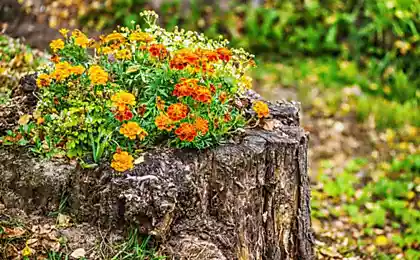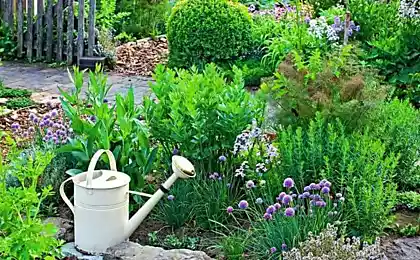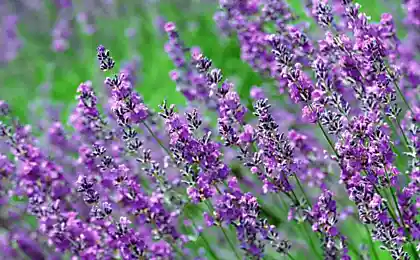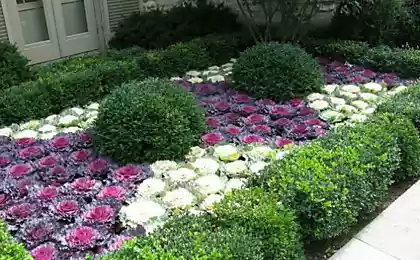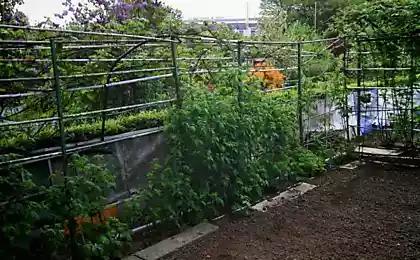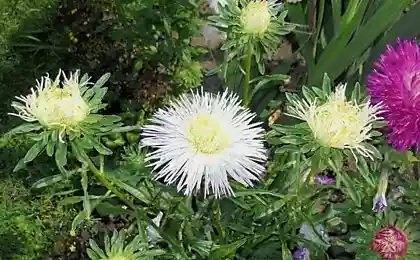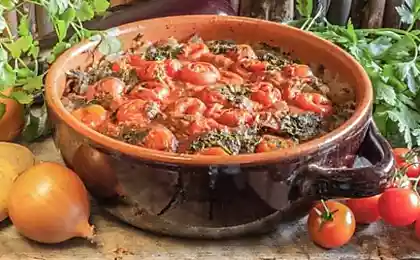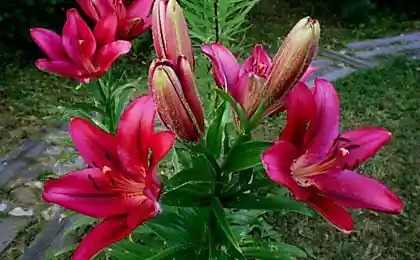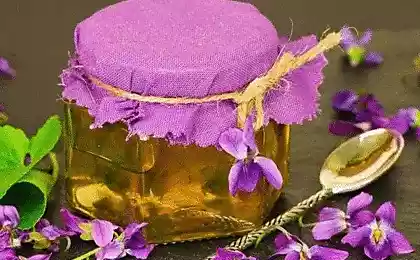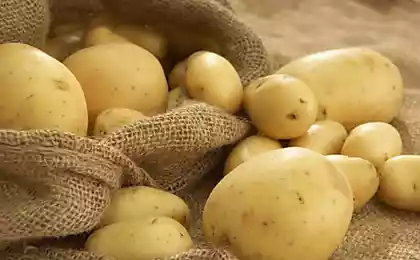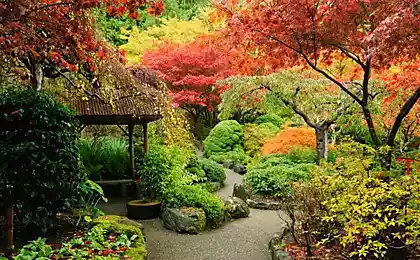572
Thyme in your garden: planting and care
If all the thyme, the space was home comfort, which create a spicy, warm scent of thyme, and a dense "carpet" of its leaves and flowers. The thyme is happy in the garden. It goes well with most plants and is often used as povorotny.
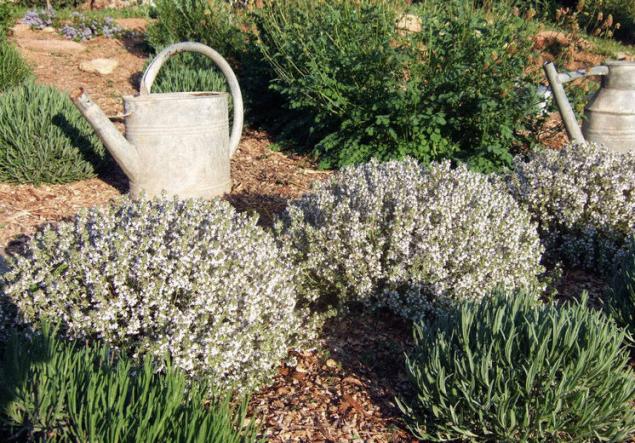
Small bright leaves of thyme in combination with the low-growing hyssop and cloves will decorate any container and a small bed. Walking through the garden, run your hand over the Bush of thyme, and you will find yourself in a cloud of spicy fragrance. And the cold winter evenings tea from this pot is able to warm not only the body but also the soul.
Thyme — a bright representative of the family Lamiaceae. And his family has over 400 species, native of almost the entire territory of the former USSR. The European part of the happy 50 different kinds.In Siberia and the Caucasus grow 40 types. This shrubs with semi-lying, ascending or ascending woody stems
The most common thyme (Thymus vulgaris) and creeping thyme (Thymus serpyllum). The second part is called thyme. We should also mention varieties of thyme with strong lemon smell.
Capitate inflorescences with white, purple, pink flowers.
Planting thyme Select in your garden for thyme light, warm place. In the shadow of his elongated stems and begin to grow poorly. In an extreme case, the allowable light partial shade.
The reaction of the soil for better growth of thyme should be neutral or alkaline. In composition it is best to choose a light soil, well drained and fertile. On heavy clay soils with an excess amount of moisture the plant can podpevat, it is here that drainage will be a real salvation. Mulch the soil around thyme can be small pebbles, gravel, even gravel, when there is nothing else at hand.
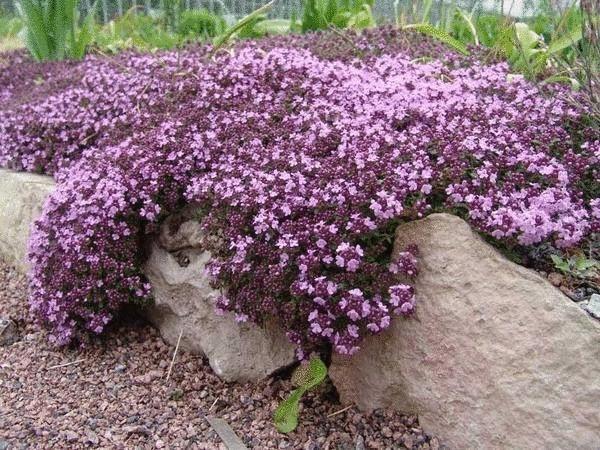
To plant thyme can both early spring and in the beginning of autumn, so that thyme could well take root and not die in the winter. Winter, by the way, thyme is very well tolerated. In the snowy winter, does not need shelter, but if the snow is not enough, it is better to cover the planting of spruce branches.
Propagation of thyme
Seeds This method of reproduction is good, if you want to get a large number of planting material. Spring on the ridge or in the greenhouse sown seeds. After the appearance of very small seedlings need to ensure that weeds do not interfere with the development of young seedlings. When you're older, excess to break through.
Many gardeners sow the seeds of thyme seedlings at home in containers, and has grown transplanted into the garden. Soil mix for thyme on the composition of the light sand and peat (1:1). At home sowing when the seedlings temperature is lowered and moderately moisturize.
Lightly spray small seedlings when the top layer of soil begins to dry. With early sowing and seedling planting thyme bestow flowering in the first year of planting. Under normal planting will bloom in the second year.
Vegetarianrecipe — cut green stalks from the creeping shoots and planted in a permanent place of residence, or a hothouse for rearing. Reproduction thus can be produced throughout the growing season. Very low-growing prostrate varieties can be propagated by cuttings, not more than 5 cm the easiest way is to plant them under the Bank, moderately moisturizing. Waterlogging should not be, to avoid the problem of root rot. A couple of weeks the cuttings will be rooted.
Division of the Bush — the Bush is dug and gently separated the roots, sit them out on a pre-prepared places.
Care titanomaghemite. For thyme will fit a small amount of compost and horn meal. The fertilizer thyme undemanding.
Trim. After flowering or in spring cut the bushes of thyme, this will not only give them a form, but also externally sealed them. Shorten stands up to a stiff part, which is about 2/3 of the length of the stem.
Watering. Thyme not require irrigation, but in hot, dry summers it's worth sometimes to water it, that he had power to blossom beautifully.
Pests and diseases. Thyme is great because practically not affected by diseases and pests.
The types of thyme
Flea thyme (Thymus pulegioides)Dense small shrub with leaves slightly more than 1 cm decorated with dense heads of pink-purple flowers. Flowering species occurs in June.
Thyme (Thymus vulgaris L.)
Refers to medicinal plants. Leaves small, on the inner side are pubescent. Shoots up to 15 cm in height. Refers to this several beautiful varieties of dwarf types. In this species there are varieties with different colored flowers: "Alba" — white, "Splendens" — thick red. From dwarf varieties, select the "Elfin" — a total of some 5 cm in height, but forms a dense, neat pillow with a diameter of not more than 15 cm.
Linonophobia thyme (Thymus x citriodorus (Pers.) Schreb)
It is a hybrid of two species: pulegioides and vulgaris. In the winter requires shelter, as relatively heat-loving and do not like sudden temperature drop. It shoots reach 30 cm in height. A very beautiful variegated leaves and round shape. The plant is a perennial and needs a haircut to maintain shape and density.
Under thyme (Thymus doerfleri ronn)
Rarely found in culture, lives in the Balkans. He is handsome, but not very tolerant of freezing. Flowers of gray-pink color, and the leaves covered with white hairs and curved, makes a feeling that they froze in the wind.
The subarctic thyme (Thymus subarcticus Klok. & Shost)
This kind of thyme is very common in the forest zone of Eastern Europe and the Ladoga lake. Low perennial plant in the form of polyesterlike. Concentrations of the thyme form dernovichi. The thin trunks are straight, like soldiers, pleasing bright purple capitate inflorescences. The flowers are bell-shaped form, and the leaves and stems are pubescent. The pair is finished with a gorgeous smell plants, talking about a large number of essential oils. Oil performs a protective function, protecting the thyme from dryness and burning sun.
Early thyme (Thymus praecox'opiz)
In common culture 2 varieties of this species.
1. Minor
This low-growing shrub is comparable with a knitted sweater. Very fluffy and juicy. The leaves are very small, the flowers do not attract attention. All its beauty is in its pubescence and juicy light green color, thanks to which he as a bright spot for the Alpine hills, rockeries, in flower beds. Yes, and the pond in combination with stones this variety of thyme will delight the eyes of owners and guests.
2. Pseudolanuginosus
You ever seen a carpet of flowers? When planting this variety of thyme will be surprised how it changes during the flowering period. A little fluffy leaves astrawtsa larger lilac flowers. Flowers so much that the greens practically is not visible.
Creeping thyme (Thymus serpyllum L.)
Creeping thyme is known to most under the name of thyme, and in Russia it is affectionately called "Bogorodskaya grass". It is a perennial plant with creeping stems and cylindrical leaves that form on the ground with a dense carpet with twisted stems. If you like variegated forms and rich colors of Carmine, white, pink, this is exactly what you need. The stems reach 15 cm in height, in the culture used more than a century.
Whatever type of thyme you choose for your garden, certainly will not be disappointed. Unpretentious, ornamental, aromatic and medicinal plant that can be eaten. published
P. S. And remember, only by changing their consumption — together we change the world! ©
Source: www.7dach.ru

Small bright leaves of thyme in combination with the low-growing hyssop and cloves will decorate any container and a small bed. Walking through the garden, run your hand over the Bush of thyme, and you will find yourself in a cloud of spicy fragrance. And the cold winter evenings tea from this pot is able to warm not only the body but also the soul.
Thyme — a bright representative of the family Lamiaceae. And his family has over 400 species, native of almost the entire territory of the former USSR. The European part of the happy 50 different kinds.In Siberia and the Caucasus grow 40 types. This shrubs with semi-lying, ascending or ascending woody stems
The most common thyme (Thymus vulgaris) and creeping thyme (Thymus serpyllum). The second part is called thyme. We should also mention varieties of thyme with strong lemon smell.
Capitate inflorescences with white, purple, pink flowers.
Planting thyme Select in your garden for thyme light, warm place. In the shadow of his elongated stems and begin to grow poorly. In an extreme case, the allowable light partial shade.
The reaction of the soil for better growth of thyme should be neutral or alkaline. In composition it is best to choose a light soil, well drained and fertile. On heavy clay soils with an excess amount of moisture the plant can podpevat, it is here that drainage will be a real salvation. Mulch the soil around thyme can be small pebbles, gravel, even gravel, when there is nothing else at hand.

To plant thyme can both early spring and in the beginning of autumn, so that thyme could well take root and not die in the winter. Winter, by the way, thyme is very well tolerated. In the snowy winter, does not need shelter, but if the snow is not enough, it is better to cover the planting of spruce branches.
Propagation of thyme
Seeds This method of reproduction is good, if you want to get a large number of planting material. Spring on the ridge or in the greenhouse sown seeds. After the appearance of very small seedlings need to ensure that weeds do not interfere with the development of young seedlings. When you're older, excess to break through.
Many gardeners sow the seeds of thyme seedlings at home in containers, and has grown transplanted into the garden. Soil mix for thyme on the composition of the light sand and peat (1:1). At home sowing when the seedlings temperature is lowered and moderately moisturize.
Lightly spray small seedlings when the top layer of soil begins to dry. With early sowing and seedling planting thyme bestow flowering in the first year of planting. Under normal planting will bloom in the second year.
Vegetarianrecipe — cut green stalks from the creeping shoots and planted in a permanent place of residence, or a hothouse for rearing. Reproduction thus can be produced throughout the growing season. Very low-growing prostrate varieties can be propagated by cuttings, not more than 5 cm the easiest way is to plant them under the Bank, moderately moisturizing. Waterlogging should not be, to avoid the problem of root rot. A couple of weeks the cuttings will be rooted.
Division of the Bush — the Bush is dug and gently separated the roots, sit them out on a pre-prepared places.
Care titanomaghemite. For thyme will fit a small amount of compost and horn meal. The fertilizer thyme undemanding.
Trim. After flowering or in spring cut the bushes of thyme, this will not only give them a form, but also externally sealed them. Shorten stands up to a stiff part, which is about 2/3 of the length of the stem.
Watering. Thyme not require irrigation, but in hot, dry summers it's worth sometimes to water it, that he had power to blossom beautifully.
Pests and diseases. Thyme is great because practically not affected by diseases and pests.
The types of thyme
Flea thyme (Thymus pulegioides)Dense small shrub with leaves slightly more than 1 cm decorated with dense heads of pink-purple flowers. Flowering species occurs in June.
Thyme (Thymus vulgaris L.)
Refers to medicinal plants. Leaves small, on the inner side are pubescent. Shoots up to 15 cm in height. Refers to this several beautiful varieties of dwarf types. In this species there are varieties with different colored flowers: "Alba" — white, "Splendens" — thick red. From dwarf varieties, select the "Elfin" — a total of some 5 cm in height, but forms a dense, neat pillow with a diameter of not more than 15 cm.
Linonophobia thyme (Thymus x citriodorus (Pers.) Schreb)
It is a hybrid of two species: pulegioides and vulgaris. In the winter requires shelter, as relatively heat-loving and do not like sudden temperature drop. It shoots reach 30 cm in height. A very beautiful variegated leaves and round shape. The plant is a perennial and needs a haircut to maintain shape and density.
Under thyme (Thymus doerfleri ronn)
Rarely found in culture, lives in the Balkans. He is handsome, but not very tolerant of freezing. Flowers of gray-pink color, and the leaves covered with white hairs and curved, makes a feeling that they froze in the wind.
The subarctic thyme (Thymus subarcticus Klok. & Shost)
This kind of thyme is very common in the forest zone of Eastern Europe and the Ladoga lake. Low perennial plant in the form of polyesterlike. Concentrations of the thyme form dernovichi. The thin trunks are straight, like soldiers, pleasing bright purple capitate inflorescences. The flowers are bell-shaped form, and the leaves and stems are pubescent. The pair is finished with a gorgeous smell plants, talking about a large number of essential oils. Oil performs a protective function, protecting the thyme from dryness and burning sun.
Early thyme (Thymus praecox'opiz)
In common culture 2 varieties of this species.
1. Minor
This low-growing shrub is comparable with a knitted sweater. Very fluffy and juicy. The leaves are very small, the flowers do not attract attention. All its beauty is in its pubescence and juicy light green color, thanks to which he as a bright spot for the Alpine hills, rockeries, in flower beds. Yes, and the pond in combination with stones this variety of thyme will delight the eyes of owners and guests.
2. Pseudolanuginosus
You ever seen a carpet of flowers? When planting this variety of thyme will be surprised how it changes during the flowering period. A little fluffy leaves astrawtsa larger lilac flowers. Flowers so much that the greens practically is not visible.
Creeping thyme (Thymus serpyllum L.)
Creeping thyme is known to most under the name of thyme, and in Russia it is affectionately called "Bogorodskaya grass". It is a perennial plant with creeping stems and cylindrical leaves that form on the ground with a dense carpet with twisted stems. If you like variegated forms and rich colors of Carmine, white, pink, this is exactly what you need. The stems reach 15 cm in height, in the culture used more than a century.
Whatever type of thyme you choose for your garden, certainly will not be disappointed. Unpretentious, ornamental, aromatic and medicinal plant that can be eaten. published
P. S. And remember, only by changing their consumption — together we change the world! ©
Source: www.7dach.ru
10 examples of the influence of pharmaceuticals on the nature
Treatment with the juice of burdock — old proven tool



